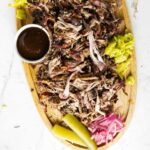BBQ Smoked Pork Butt
Smoked pork butt done low and slow on the pellet grill with an injection marinade for juicy, flavorful meat and a deep, crackly bark.
Servings: 16 servings
Equipment
Ingredients
Injection Marinade
- 1 cup beef broth
- ¼ cup apple cider vinegar
- 2 tablespoons soy sauce
- 1 tablespoon Worcestershire sauce
- 1 tablespoon hot sauce Frank’s or similar
- 2 teaspoons salt
For the Pork Butt
- 7 to 9 pounds pork butt (Boston butt), boneless or bone-in
- ¼ cup yellow mustard or whole grain mustard
- ½ cup BBQ dry rub or your favorite dry rub
Instructions
Prep the Pork Butt
- Start by trimming off the thick outer fat cap. Leave about ¼ inch of fat, just enough to keep things juicy.
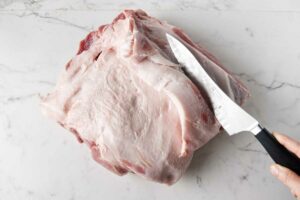
- Combine the broth, vinegar, soy sauce, Worcestershire, hot sauce, and salt in a large cup. Place the pork butt in a shallow pan to catch drips.
- Load up your meat injector and pump the marinade deep into the pork in several spots, spacing the injections about 1 to 2 inches apart. The meat will plump up slightly, and a little liquid will seep out. That’s normal.
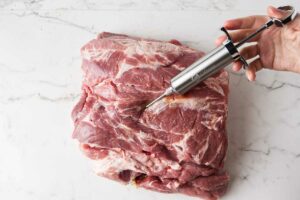
- Pat the pork dry with paper towels. Slather it generously with the mustard.
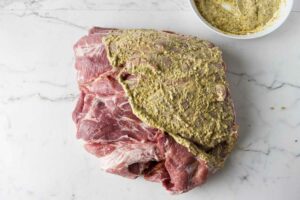
- Sprinkle the dry rub over the meat, pressing it in to coat every nook and cranny. Don’t forget the sides and bottom.
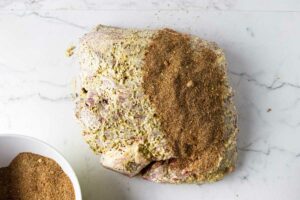
- If you have time, wrap the pork butt in plastic and refrigerate overnight. If not, you can go straight to the smoker.
Fire Up the Pellet Grill
- Set your Traeger to 225°F. Use hickory or oak pellets for bold smoke, or try cherry wood if you want a slightly sweeter edge.
- Place the pork butt directly on the grill grates, fat side up. Insert a probe thermometer into the thickest part, close the lid, and go find something else to do for the next several hours.
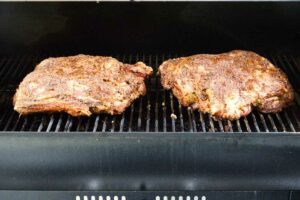
Deal with the Stall
- Around 150°F to 165°F, the meat will hit a stall and seem like the temperature stops rising. You can wrap it to push it through the stall faster, or leave it unwrapped for a longer cook and a thicker, crustier bark. Check the notes for more details
- We usually go with paper. It speeds things up a bit but still lets the meat absorb smoke and develop that crusty bark.
Finish and Rest
- Let the pork smoke until it hits 203°F internal temp. This could take 12 to 15 hours depending on the size of the butt and how often you peek at it (stop doing that).
- Once the pork is done, pull it from the grill and wrap it tightly in butcher paper if it isn’t already. Then swaddle it in a couple of thick towels and stick it in an empty cooler (no ice, obviously). Let it rest for at least an hour and up to four hours. That cooler does a great job holding the temperature steady for hours and somehow the pork turns out even juicier.
- Shred the pork using bear claws or two forks. Toss out any big chunks of fat that didn’t melt down. Serve it piled onto buns, tacos, nachos, or eat it straight from the cutting board like an animal.
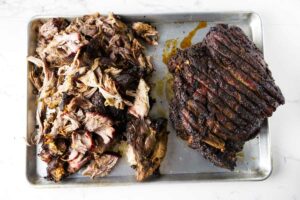
Notes
Boneless vs. bone-in: Either works fine. Boneless pork butt may cook slightly faster and is easier to shred.
Injection swaps: You can sub apple juice, beer, or even pickle juice for the beef broth in the marinade depending on your flavor preference.
Want to slice instead of shred? Pull the pork off the smoker at 175°F, then rest it the same way. You’ll get tender slices with a touch of chew.
Rest time matters: That long cooler rest makes a big difference and creates juicy, tender meat. Aim for at least an hour, and don’t skip wrapping in towels. It holds the temp surprisingly well.
About the stall
When the internal temperature hits 150°F to 165°F, the pork’s internal temperature will plateau for several hours. At this point, choose one of the following methods:- No wrap: The pork butt will take longer to break the stall and it will have a thicker bark.
- Wrap in butcher paper: This speeds up the cook while still allowing smoke in and preserving the bark.
- Wrap in foil: This gives the fastest cook time, but it traps moisture and softens the bark.
Nutrition
Serving: 1 serving | Calories: 275kcal | Carbohydrates: 2g | Protein: 38g | Fat: 12g | Saturated Fat: 4g | Polyunsaturated Fat: 1g | Monounsaturated Fat: 5g | Trans Fat: 0.1g | Cholesterol: 119mg | Sodium: 680mg | Potassium: 719mg | Fiber: 0.4g | Sugar: 0.3g | Vitamin A: 62IU | Vitamin C: 1mg | Calcium: 55mg | Iron: 3mg
